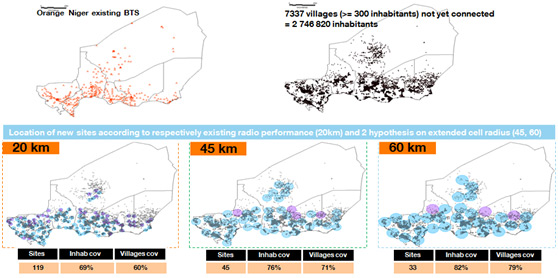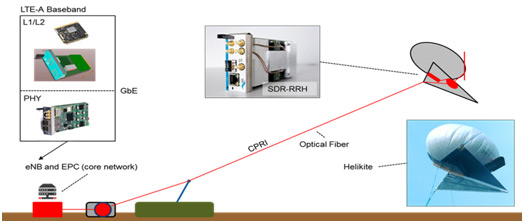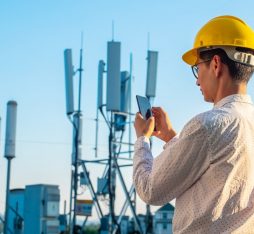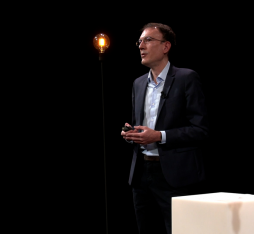Summary
The 5G dynamic is a true opportunity to mobilise the ecosystem in bridging the gap of internet connectivity in sparsely populated areas, particularly in rural areas of emerging countries.
Extreme coverage, i.e. increasing cell radius, enables mobile network operators to considerably reduce the number of sites needed to expand their coverage, as the main costs of a network lie with deployment and operation of access sites (tower, energy, maintenance). Typically, a cell radius of 45 km, or even 60 km in low-density areas, can be achieved by combining the following solutions: increasing the number of sectors per gNodeB (5G base stations), signal repetition software mechanisms, increasing antenna height or integrating them in aerial platforms…
Orange, who initiated the extreme coverage requirements right from the start of 5G discussions, is carrying out a project on next generation mobile networks called “Extreme long-range communications for deep rural coverage”, in order to build momentum to develop economically viable solutions to address emerging markets.
Full Article
The momentum for 5G is a real opportunity to mobilize the telecom ecosystem for bridging the gap of providing Internet connectivity to unserved areas, typically rural areas in emerging countries.
According to ITU (International Union Telecommunications), Internet penetration figures in June 2018 report that more than 4 billion people, representing 45% of world’s population, are not connected to the Internet. Specifically, 74.6% of people in Africa still lack basic Internet access. Although part of the population leaving in dense areas can already access Internet thanks to 3G and 4G networks, the major part lives in low density rural areas. This implies that there are still significant opportunities for telecom operators to tap into by offering basic Internet services to unconnected people who live there.
Coverage extension is still a key issue for mobile network operators
Although that coverage extension is a key issue for mobile network operators, cellular market models and technology solutions driven by mature economies are not adequate and sufficiently tailored to capture the potential of such underserved markets. The current trend is to deploy small cells in a single box (e.g., Open Cellular project) in order to reduce the cost of the passive infrastructure (site rent, tower/mast, energy consumption), but it requires deploying as many sites as unserved villages.
The 5G standardization process was an opportunity to rethink technologies and network operating models to better address emerging market challenges and to develop cost efficient solutions to offer Internet access there. Moreover, coverage extension is also a key issue in many harsh areas everywhere in the world, such as deep indoor (e.g., parking), maritime areas along the coast, isolated roads…
Extreme Coverage (Figure 1), i.e. Long Range Communication, definitely empowers mobile operators to expand their coverage footprint because the main costs of a network reside in deploying and operating access sites (tower, energy power, travelling for maintenance).

Figure 1: Illustration of coverage extension in blue where existing coverage is in red.
Increasing the cell radius range enables to significantly reduce the number of sites. For instance, in the context of Niger, we evaluate that there are 2,746,820 people who live in uncovered villages having more than 300 inhabitants. Figure 2 shows the impact of cell radius for extending coverage, considering that the profitability criteria for deploying a new cell being that the cell should cover at least cover 3000 inhabitants. In the case of a traditional deployment, it would require to deploy theoretically 119 sites to extend coverage to 60% of uncovered villages having more than 300 inhabitants. If radio technology improvement allows 45 km cell radius, a small number of sites (45) would be required to cover more villages (71%) since the profitability criteria (> 3000 inhab.) can be reached by the increased coverage of each cell. If we consider 60 km cell radius, deploying only 33 new sites would cover 79% of villages having more than 300 inhabitants and 82% of population living in the uncovered areas.

Figure 2 Illustration of coverage extension at country scale (e.g., Niger).
It is interesting in the context where capacity requirements can be lowered, typically in the context of low-density areas (e.g., less than 5 inhabitants/km²) in step with 3GPP requirements on extreme coverage in 3GPP SMARTER study (Technical Report 22.863) [1]. The cell radius objective taken in this 3GPP study is 100km in respect with the LTE timing advance max value (taken as a reference), whereas the cell radius is 15km for 2G GSM rural cells, and possibly 30km thanks to using half rate codecs. In practice, 45km cell radius, or even 60 km in very low dense areas, can be reached by combining the following solutions.
3GPP existing specifications are a first step for extending coverage at low cost
Increasing the number of sectors per gNodeB (5G Base Stations) is well known for increasing capacity and for improving also cell range a little bit, but adds a cost. Unfortunately, this is poorly improving the situation on uplink (information sent by the end-user device up to the base station) in the context of using standardized UE (User Equipment, typically smartphones).
One of the least costly approach for increasing the cell radius range can be achieved by reusing signal repetition software mechanisms defined initially for MTC (Machine Time Communications) [2] such as NB-IoT (Narrowband IoT) and LTE-M (LTE for Machine-Type Communications) in 3GPP release 13, and by adapting them for Internet connectivity.
CE (Coverage Extension) mode of 3GPP release 13 operates in 1.4MHz narrow band over any 6 PRB (Physical Resource Blocks) of a LTE carrier frequency with 1Mbps peak throughput. Power Spectral Density boosting and repetitions are used to reach devices in poor coverage. Furthermore, control and data signals can be repeated in time-domain and transmitted (sub-frame crossing) to reach the required coverage enhancements. LTE-M uses specially designed control channel for Layer 1 scheduling control. LTE-M can transmit information in repeating fashion, up to 2000 repetitions can be configured in Layer1. This is to make these channels decodable even when the signal quality/power is very poor in harsh radio conditions.
In 3GPP release 14, eMTC adds features that are interesting for data coverage extension: 5MHz bandwidth with 4Mbps UL and DL peak throughput and support for VoLTE (Voice over LTE), but is still not fully appropriate for Internet/video applications.
In 3GPP release 16, these CE mechanisms should be reused, adapted and merged with 5G NR (New Radio) in order to enable both CE and a latency adapted to Internet applications. The repetitions can be switched on and their number adapted in respect to the path loss with each UE.
Smartphones should support signal repetition mechanisms similar to gNodeB in order to exchange with them. 3GPP does not restrict CE mode to MTC UEs such as Cat M1 and Cat M2 so that smartphones UEs (Cat 1, 4, 6…) can benefit from CE mode whereas they are less constrained on energy than MTC devices. 5G UEs should support downlink MIMO 2×2 (Multiple Input Multiple Output for achieving beamforming) operated with CE mode, mobility enhancements and higher transmission power than MTC UEs.
Advances in aerial platforms are also a key enabler for large cells
Another parameter having a major impact on cell radius range is the altitude of antennas. But building very high towers has a serious cost. According to the authors of the paper ‘Designing and Implementing Future Aerial Communication Networks’ [3], aerial platforms are getting enough maturity today for envisaging embedding antennas and gNodeB on board. Two options can be considered: High Altitude Platforms, Low Altitude Platforms such as tethered balloons or drones.
High Altitude Platforms, e.g., Google Loons, Zephyr unmanned aircraft, Stratobus airship offer the advantage of having no footprint on the ground but are still facing challenges for permanent deployment for mass-market connectivity (e.g., regulation on frequencies, longevity, autonomous control, size of the payload, costs). Their situation from 17 to 22 km above the ground suits large coverage (typically 60km radius range), especially in case they can support multi-beams, but suffer from limitations on uplink with traditional UE. Costs may drop if there are other profitable markets enabling mass production (e.g., imaging for monitoring). Solutions for 5G NR to support Non-Terrestrial Networks are discussed at 3GPP release 16 in order to study proposals that fit requirements defined in TS 22.261.
Low Altitude Platforms operate between a few tens of meters to a few hundreds of meters above the ground. Some trials have been made for temporary usage such as disaster recovery or temporary events. If takeoff and landing can be achieved in a full autonomous way, tethered aerial platforms are serious candidates for Extreme Coverage thanks to 5G functional split that enables to reduce the requirement on the embedded payload: the antennas embedded in the platform can be linked to processing units located on ground thanks to attaching a fiber along the cable (Figure 3).

Figure 3: Connectivity provided by a Low Altitude Platform demonstrated at the final review of the IST FP7 Absolute project.
Orange research activities are encouraging for the next steps
An implementation in open-source Open Air Interface is on-going and a trial on a real site is expected by November for achieving real measurements on the field (a 70 meter high tower).
5G is a real opportunity for tackling other major issues of emerging countries low-density rural areas. Typically, 5G wireless self-backhauling techniques included in 3GPP release 15 are a good candidate for backhauling large range cells because fibers are costly to deploy and microwave links require high tower for achieving Line of Sight properties considering the Fresnel Zone. In addition to this, flexibility and extensibility properties of 5G architectures are promising for reducing operational costs thanks to network function virtualization, typically in the case of small configurations needed to start with few clients.
Orange is active in standardization in order to mobilize the telecom ecosystem. Orange has initiated the Extreme Coverage requirements at the beginning of discussions on 5G. These requirements where supported by partners interested by large coverage in large territories with very low density (large territories in Australia, isolated roads in US) as well as maritime use cases. Orange is leading a project in NGMN (Next Generation Mobile Networks) named ‘Extreme Long Range Communications for Deep Rural Coverage’ to make an impact in the telecom ecosystem and create momentum to make develop Long Range Communications solutions needed to address undeserved emerging markets.
References:
[1] 3GPP TR 22.863 (SA1 WG) FS_SMARTER – enhanced Mobile Broadband: Feasibility study on new services and markets technology enablers for enhanced mobile broadband
[2] M. Wang et al., “Cellular machine-type communications: physical challenges and solutions,” in IEEE Wireless Communications, vol. 23, no. 2, pp. 126-135, April 2016.
[3] David Grace and all, “Designing and Implementing Future Aerial Communication Networks.”, in Ieee communications magazine, Vol. 54, No. 5, 05.2016, p. 26-34. (https://ieeexplore.ieee.org/document/7470932)
[4] R. Favraud, N. Nikaein, “Wireless Mesh Backhauling for LTE/LTE-A Networks,” IEEE MILCOM 2015, pp. 695-700, Oct. 2015
[5] B. Debaillie, C. Desset and F. Louagie, “A Flexible and Future-Proof Power Model for Cellular Base Stations,” 2015 IEEE 81st Vehicular Technology Conference (VTC Spring), Glasgow, 2015, pp. 1-7.











